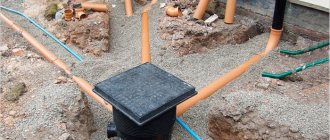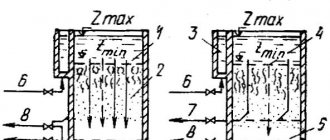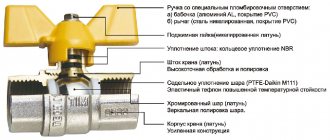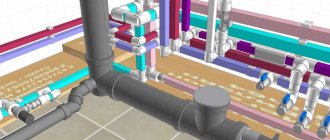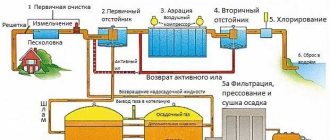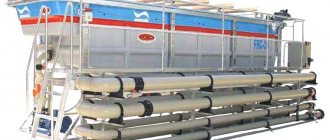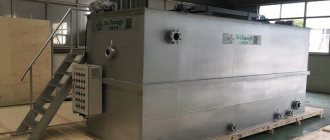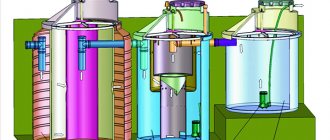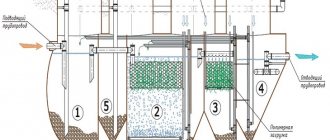How to avoid paying for sewerage
Payment for sewerage is mandatory for all citizens living in Russia, and cancellation is not provided. However, on April 16, 2013, the Government of the Russian Federation issued Resolution No. 344, according to which the determination of the standard for wastewater disposal for general house needs is canceled.
Consequently, now the payment for the removal of water for public use should not be included in the receipt (unless otherwise specified in the agreement with the water utility or management company). Otherwise, consumers have the right to file a lawsuit against the violators and demand a recalculation, taking the volume of consumption according to the meter as a basis.
Receipt with an error in favor of the consumer
The consumer may receive receipts with reduced rates if the management company did not take into account one or more residents registered in the apartment. In this case, the receipt will indicate the amount calculated based on the old number of registered residents in the apartment.
An error in the number of registered residents will result in growing debt. In fact, unregistered residents will also use the services, so the accumulated debt will in any case fall on the shoulders of the homeowner.
Sooner or later the error will come to light. The Management Company will establish the fact of an error in the number of registered residents, and then demand compensation for losses from the owner of the property.
The management company has the right to demand payment of the accumulated debt only for the past 3 years.
This means that a homeowner who pays utilities without taking into account one of the registered residents for 5 years is obliged to pay the resulting debt for only 3 years. Accordingly, the management company is obliged to calculate the debt only for 3 years, leaving the remaining 2 years without attention.
If the management company does not agree with this provision, the user has the right to go to court.
Rate this post
In legislation
What wastewater disposal (WDU) is is stated in regulations. The law regulates both the supply of water and its purification, which must be carried out in a timely manner. The amounts charged for the use of a service such as sewerage are by no means the whim of the management company. You can verify this by reading the Federal Law that came into force in 2011.
Previously, the utility services sector was largely regulated by separate regulations. But in 2011, a law was passed according to which all organizations that supply and dispose of water are responsible for the quality of services provided and the production process. Residents, in turn, are obliged to make payments on time, that is, before the tenth day.
How to pay for sewerage
Like any other utility services, you must pay a fee per calendar month for sewerage to your apartment. The payment deadlines are quite clear. At the end of the reporting period, a receipt is sent to the consumer, indicating the amount due. Rent must be paid by the 20th day of the month following the reporting month.
Otherwise, defaulters who owe money will be subject to penalties in the form of a fine for each day of late payment. Delaying payment will entail consequences, since the water utility will consider that its interests have been violated.
What do we pay for?
There is no division in payments for utility services, therefore the total amount is calculated for the consumption of resources and for services, as stated in the “Rules for the provision of housing and communal services for owners and users of premises.” The meaning of the decree is this: even if your apartment does not consume one of the resources, if you turn it off, you will still have to pay. Example: there is no installation of an individual gas meter for a neighbor, but the house is supplied with gas, you pay not only for yourself, but also for your neighbor.
And although consumption shows the same amount of one resource (as much comes in, the same goes out), tariffs for sewerage and water supply are calculated differently
In this case, it does not matter at all that the user does not drain all the incoming water into the sewer; some goes for watering plants, some for drinking, etc. However, with all the seeming injustices of the housing and public utilities sector, we should not forget that the used flows are necessarily sent to treatment facilities, where deep biological treatment is carried out and the user also pays for this
Difference between drainage and sewerage
You can often come across the opinion that sewerage is the same as sewerage. But this is not so, and to make sure of this, let’s look at the differences between them. If drainage involves directly removing wastewater from a home and then transporting it, then sewerage involves, in addition to removing wastewater from the premises, also its subsequent cleaning and disinfection in order to later be used for technical purposes or returned to the reservoir.
This means that sewer fees mean that the wastewater will be treated and conditioned, and ultimately returned to the ecosystem. For the operation of all the systems required for this, funds contributed by consumers are needed, and the purity of the water, which will then be used again for water supply, is determined by how well the complex of treatment facilities functions.
But the concepts of drainage and sewerage are confused, and sometimes even considered synonymous, for a reason: they have a lot in common. First of all, this relates to the removal from the premises in which the water was used, its further disposal both inside the house and outside it, and then to further transportation - all this will be done the same in both cases.
Formation of tariff for drainage
The tariff for water disposal is subject to separate determination in each region, which is carried out by a special authorized body.
- The parameters for calculation are the following indicators:
Climatic features of each specific area. Condition of sewer networks. Condition of water supply networks. Distance for pumping water and waste. Condition and quality of pumping station equipment. The number of citizens consuming this service. Payment for the work of emergency crews responsible for maintaining the condition of the network. Ensuring and monitoring the performance of automated control systems. Payment to water utility workers.
- As an example, several tariffs for wastewater disposal:
Rostov region — 24.26 rubles/cubic meter Moscow region — 23.43 rubles/cubic meter Surgut — 25.44 rubles/cubic meter
What legal acts regulate the process?
The main legal act regulating the activities of housing and communal services in the provision of wastewater drainage services is Federal Law No. 416 dated November 29, 2011. But, in addition to the main Law, the topic of drainage is touched upon in the Housing Code of the Russian Federation, the Urban Planning Code, the PP on “Sanitary Well-Being...”, other legal documents.
How is drainage calculated on the receipt?
Let's look at how to calculate drainage:
- To calculate the final amount, you should separately multiply the wastewater tariff for hot and cold water supply by the volume used.
- To find out the volume used, they look at the drainage meters, and then calculate it by calculating the difference in readings of the current value from the previous period.
- Both results are summed up, thus the total amount for drainage of all incoming liquid will be calculated;
We looked at a way to calculate water drainage using meters, but not all residential premises have them installed.
Important!
If your house does not have water consumption meters, then payment for water supply will be based on average indicators, which are sometimes much higher than what the residents actually used for their needs.
Prices for water meters
Deliberate drainage of water
Housing and communal services have the right to demand payment for intentional drainage of water only in a situation where it was made by the owner of the premises, or the noted situation occurred due to leaks and improper condition of the system in the apartment. Note that it is worth draining the water periodically, but the issue of payment remains open.
According to current standards, owners are obliged to monitor the integrity and safety of their property, and if it is determined that the drain occurred due to the owner’s negligence, he will pay. But if the sewage system is new, and everything is in order in the apartment, then the housing and communal services will pay for the intentional drainage.
If there is a deliberate drain of water by housing and communal services employees, consumers will not pay for it. If the payment slip indicates otherwise, that is, there is an unlawful charge of payment, they have the right to contact law enforcement officers with a complaint against the utility companies.
Tariffing or self-payment
Calculating the receipt column is quite simple: water disposal is equal to the sum of hot water and cold water multiplied by the tariff. For example, the supply of water flows is 20 m3, the tariff is 20 rubles, the total amount is 400 rubles. However, if the payment line shows a total receipt of 20 m3, and a total drainage of 25 m3, this is unacceptable; there is a common deception of public utilities, which can be challenged in court.
Apartment buildings often have a common building meter, which shows the amount of payments, but if it does not exist, the calculation is issued by the housing and communal services through the service provider company. If necessary, you can always install your own meter by first submitting an application for installation of the device. As soon as the permit is issued, the meter is installed, sealed and the amounts due for payment are recalculated. Look at the photo to see what the counter looks like.
What is KPU? This question is often asked by users. KPU is a collective metering device installed in a common household manner. In other words, KPU is a counter that shows how much sewage has been drained over a given period of time. However, the abbreviation KPU is not in any official document; in the lines and columns there is “Common house or common house. utility metering devices." It turns out that the KPU is an invention of the housing and communal services sector and nothing more, especially since the use of abbreviated names of devices in official documents is not allowed unless specified by the rules or an addition to the resolution.
So, the fee calculated for sewerage can be checked independently, and in case of the slightest violations when issuing payments for utility services, you can go to court with the housing and communal services. If there is no meter, the amount is calculated according to standard standards established annually. You can find out the standards either from the management company or on the website of the administration of the city or locality.
And, most importantly: Decree of the Government of the Russian Federation dated April 16, 2013 No. 344, payment for housing and communal services for wastewater consumption has been cancelled. Cancellation date: 06/01/2013. The document “On Amendments to Certain Acts of the Government of the Russian Federation on the Provision of Public Utilities,” therefore, if your housing and communal services do not know about this, it would be useful to remind them of this by attaching a photo or copy of the document.
The article was written based on materials from the sites: domdomoff.ru, fb.ru, realtyinfo.online, 1kvartirka.ru, vodakanazer.ru.
How to calculate the cost of a service
How many cubic meters of water a tenant uses in a month is how much he must pay. If ten cubic meters of cold water were used, then the indicator that is in the “Tariff” column must be multiplied by 10. The same with hot water. But how is the calculation for sewerage done?
Both cold and hot water are recycled. When calculating, you should multiply the tariff (sewage) by the total number of cubic meters consumed. That is, if eight cubic meters of cold water and four hot ones are used in a month, you should find the derivative from the numbers 12 and x. X is a tariff, which, as already mentioned, can be different. But in most cases it ranges from 20 to 25 rubles.
Payment for sewerage is divided by the number of residents if a common building meter is installed. Installing an individual one can significantly reduce the total amount on the receipt.
What is meant by drainage
What is drainage in utility bills? This is a separate line, the value of which is usually calculated in natural terms - cubic meters. The payment amount for the diversion service is calculated in accordance with the tariff. Water drainage and water supply should not be confused - these are opposite concepts. Water supply includes:
- supplying water resources to households;
- preparation and heating of hot water;
- preparation (including disinfection) of cold water;
- uninterrupted supply to residential premises.
The drainage system is responsible for the round-the-clock removal of water waste using the sewer network with subsequent processing.
Important! The assumption that drainage consists only of pouring waste into sewers is also erroneous. In fact, this is a complex technological process that is not limited to a system of interconnected pipes inside a residential building. In addition to these, this includes the transportation of wastewater to treatment plants, waste treatment and disposal.
Generally, drainage is a dependent service. Its volume for the period is determined by water supply indicators. The logic is simple - as much is consumed, so much is allocated. To transfer the calculations to the category of independent ones, it is necessary to install a separate metering device for drain flows.
Water disposal in utility bills
Many citizens of the Russian Federation do not fully understand the concept of “sewage” and, even more so, they do not understand what sewerage is in utility bills.
It seems to them that they are paying for the same thing twice, and the second time it is even more expensive. Actually this is not true.
Video: payment for housing and communal services
Used water does not just go down the drains of our sinks and bathtubs somewhere underground and get lost there.
Water disposal includes the following technological stages:
- Wastewater disposal.
- Transportation to wastewater treatment plants.
- Cleaning.
- Disposal or use for technical purposes.
Thus, it is clear that drainage is a complex process that requires serious labor and financial costs.
All these costs are included in the tariffs for sewer services.
What it is?
Many people confuse the similar names of utilities and “sewage”.
In both cases, the main “character” is water, but in completely different forms:
Since the main cost of the sewerage service consists of the subsequent stages of cleaning and disposal, the obligation to pay is assigned to absolutely all city residents living both in apartment buildings and in the private sector.
The exception is frequent residential buildings that are not connected to the general sewer system.
Calculation examples
Calculating how much you will have to pay for sewer services is quite simple.
The main thing is that water meters are installed in the house.
These can be either individual hot and cold water meters or communal meters.
Based on the readings for the reporting period, it is necessary to add up the consumption of hot and cold water.
The resulting amount is multiplied by the sewerage tariff and the amount payable for sewerage services is obtained.
For example, a user used 25 cubic meters per month. hot and 43 cubic meters of cold water. The tariff for sewerage services is 9.42 rubles per 1 cubic meter. We get the expression - (25+43)*9.42=649.54 rubles.
The calculation rules are established and approved by the Decree of the Government of the Russian Federation “On the procedure and conditions for citizens to pay for housing and utilities.”
Tariffs in individual regions and constituent entities of the Russian Federation are set by local authorities.
Their value is significantly influenced by the condition of citywide sewer systems, as well as the availability of modern treatment plants and recycling equipment.
If you don't have a meter?
Sewage services are not cheap, and those consumers whose apartments or houses do not have metering devices are not at all to be envied.
In the absence of meters for hot and cold water supply, monthly consumption is calculated based on general standards.
As is known, average consumption rates do not correspond to the actual volumes of water consumption; they are much higher.
In the absence of metering devices, the cost of monthly wastewater disposal costs is calculated as follows:
How is the payment amount calculated?
There are two ways to calculate the final cost of sewerage:
- according to meters that determine the amount of cold and hot water consumption;
- according to standards established for individual consumption.
In the first situation, to calculate the cost you need to use the following formula:
C = (RHL + RGV)*T, where
| WITH | Cost of the service for a certain period |
| RHL | Cold water consumption according to meter readings for the same period of time |
| RGV | Hot water consumption according to the meter for the same period |
| T | Current tariff |
For example, the owner of an apartment in an apartment building located in Moscow consumed 8 m³ of cold water and 5 m³ of hot water in January 2021. For drainage in January you will have to pay (8+5)*27.47 = 357 rubles 11 kopecks.
Calculation according to consumption standards is carried out if:
- The consumer does not have individual metering devices installed;
- The meter verification period has expired for more than 6 months;
- The consumer does not pay for services and does not report meter readings.
Consumption standards are determined for each region individually and depend on:
- on the form of ownership of real estate;
- on the type of use of the property;
- on the area or number of people living in a separate room.
In this situation, utility services calculate using the following formula:
C = (Hx+Hg)*T, where
| WITH | Price |
| T | Rate |
| Nx | Cold water consumption rate |
| Ng | Hot water consumption rate |
For example, the following water supply standards apply to a one-room apartment with one resident located in St. Petersburg:
Hx = 15 m³;
Ng = 7 m³.
The fee for sewerage in January 2021 will be (15+7)*30.60 = 673 rubles 20 kopecks.
In addition to the amount of water consumed and current tariffs, the amount of payment for housing and communal services, including sanitation, may be influenced by the availability of benefits valid in the region of residence of the property owner.
As a rule, benefits apply to the following categories of citizens:
- WWII participants;
- disabled people of groups I and II;
- Chernobyl victims;
- large families;
- low-income families.
The benefit amount can vary from 25% to 100%.
For example, in Moscow, WWII veterans are provided with a 50% discount on sanitation. Under these conditions, the fee for sewerage, subject to a total water consumption of 13 m³, will be 357.11/2 = 178 rubles 56 kopecks.
How to refuse KPU maintenance
and all sanctions will actually begin from this year, because the absence of a certificate of timely verification is equated to the absence of a meter as such, accordingly the Criminal Code will begin to charge at the current tariff, this time, but here the Jewish nature of some residents is very often included: and There are two people registered with me, but four people live, it’s more profitable for me without meters, and this case is now provided for: starting this year, increasing coefficients are being introduced to calculate the cost of water in apartments that are not equipped with water meters https://www.rg.ru/201. /schetchik.html.
Moscow Government Decree No. 344 dated April 16, 2013 was issued. , according to which from January 1, 2015. increasing coefficients will be applied to the standard for those who did not voluntarily install meters. Also, increasing coefficients will be applied to those who did not check on time, who did not replace a broken meter, this may also apply to those who did not allow the inspector into the apartment.
What do abbreviations mean on rent receipts?
If there are few lines, the purpose of payments is not disclosed in detail - this is the first reason for suspicion. Typically, the management company deliberately does not disclose the purpose of payments
It is worth paying attention to the total amount: if it differs from what it was a month earlier, it is better to carefully check the entire account. At the same time, after the tariff increase, we remind you that they were raised on July 1, the account should be checked especially carefully
Management companies and utility suppliers can inflate bills under the guise of a planned increase.
The payment usually consists of a number of mysterious abbreviations, and each region may introduce its own abbreviations. There are several generally accepted ones: If the KPU is indicated, it means that you pay for water using your apartment meter.
That is, the cold water that goes for heating is given in another line the price for the heating itself. By adding them up, you get the final price of hot water. These are services provided by an apartment building management company for the maintenance and ongoing repairs of common property in an apartment building. That is, if you have this line, it is assumed that order is maintained in your entrance and everything is working. This line may include various services: maintenance of in-house engineering equipment, cleaning, routine repairs, garbage removal, concierge services, etc.
In this case, the amount and services included in the receipt must be approved by the decision of the residents themselves at the meeting. There are also services that citizens do not actually use: for example, paying for an antenna and radio point. They can be waived individually by contacting the Criminal Code with a request to exclude these items from the general account. Amounts for individual consumption of utilities used in the apartment and for general house needs of one; for example, expenses for heating and lighting of the entrance in the payment slip should be posted in different columns.
There are cases when the amount of payment for the use of utilities per person per person exceeded the amount of individual consumption in apartments. This can happen when payments to ODN are calculated not according to meters, but according to standards with an increasing coefficient due to the lack of a meter. To reduce costs, owners must vote at a meeting to install meters. They are installed by resource supply organizations. You should check whether the area of the apartment is indicated correctly on the payment slip.
Heating and payments for major repairs are calculated on a per square meter basis. Regional authorities provide subsidies that compensate for part of the payments, but they operate only within the social norm in Moscow, which is 33 square meters. You will have to pay for housing surpluses. Also, do not rush to register new residents. The more people there are, the more expensive it will be, for example, for water if meters are not installed.
If one of those registered in the apartment does not live in it for a long time, then a recalculation can be achieved. You just need to prove your absence - for example, bring a certificate from the management company from your real place of residence.
The same applies to summer residence at the dacha and long business trips: if the appropriate documents are available, the management company is obliged to recalculate. Calculating how much you should pay for a new service is simple. In Moscow, the monthly fee is 15 rubles. The new line appeared in the capital in July and has already caused a wave of discontent.
However, so far the practice is not in favor of residents. In this case, you must contact the regional department of housing subsidies, presenting a certificate of income and a certificate of ownership. At the same time, there should be no excess living space: the established standards are 33 square meters. If it turns out that the bill is inflated, you need to file a complaint with the management company.
Water metering devices
Users who understand the pricing of this column are naturally perplexed, because not all incoming water goes down the drain. Part of it is consumed during cooking, watering plants, etc. and should not be counted as allocated. This issue is especially relevant for private sector farms - for owners of personal plots, most of the water goes into the ground or to fill the pool.
An effective solution could be to install an individual meter for wastewater disposal. The flow meter is installed on a sewer pipeline and is designed to operate in an aggressive environment. Manufacturers offer a wide selection of measuring equipment:
- ultrasonic;
- electromagnetic;
- lever-pendulum, etc.
Each type has its own advantages and disadvantages. When choosing, you should focus on the organization of supply and disposal, the required configuration of the device and the optimal price-quality ratio. Some of them allow you to calculate the outlet in non-pressure pipelines, where water flows under the influence of gravity. Installation is also possible in an open channel. The principle of operation is to measure the level and speed of flow. Before deciding to install such a meter, experts recommend assessing the ratio of the scale of subsequent savings to the costs of commissioning.
The provision of housing and communal services in our country still leaves room for hidden charges. Regular monitoring of calculated indicators in receipts and knowledge in the field of pricing ensures homeowners have the correct amounts in payments and the absence of overpayments for the use of resources.
Receipt with an error in favor of the management company
The main reason for inflating utility bills is to write off other people's debts at your expense. The management company charges additional amounts to taxpayers in order to reduce the amount of the principal debt on utility bills. They rely on the fact that most ordinary citizens pay their rent automatically, without thinking or checking their payment receipts.
Prevention in the fight against inflated utility bills is a careful check of each receipt for errors.
The best way to identify errors is to compare old receipts with new ones.
If you find errors in receipts or the presence of non-existent services, you must contact the management company with a written request to recalculate utility bills.
You can request a recalculation of a receipt on the following grounds:
- Inflated housing and communal services tariffs;
- Payment of non-existent workers;
- Payment for non-existent services;
- If the services indicated in the receipt were not actually performed by the management company.
As practice shows, in order to avoid litigation, management companies meet service users halfway and recalculate.
Individual meters installed for hot and cold water consumption will help reduce the risk of overpaying for housing and communal services. In this case, the service user will pay utilities only for the amount of water that he actually used. In houses that do not have individual water meters, utility bills are calculated based on average indicators, which gives Management Companies a reason to charge extra cubic meters of water.
What is drainage
When a meter is installed, the indicator is calculated based on the water used and the regional tariff. Every citizen-consumer must pay for sewerage.
In other words, water disposal is the purification of water and disposal by discharge into the sewer. Draining water when washing your face, after a shower, or from the dishwasher is all water drainage.
Water disposal is regulated on the basis of the following documents:
- Law on water supply and sanitation (dated 07.12.2011 N 416-FZ)
- Official regulations and orders at the local and regional level;
- Internal provisions of city water utilities.
How is this item shown on receipts?
Many people believe that the drainage of water resources includes only discharge into the sewerage system. In reality, the service includes the removal of a water resource after use and delivery to treatment facilities, its filtration, and so on.
If we talk about the monthly display of consumption, then if IPU is installed, the item is called - cold water supply (cold water supply) and hot water supply (hot water supply). If there is no IPU in the apartment, then the calculation is carried out based on the standards at the local level. This will appear on the receipt as follows:
- Cold water supply at OI MKD - consumption of cold water in the house;
- DHW t/n at OI MKD – hot water (volume);
- DHW heating at OI MKD - hot water (heat).
How to calculate water drainage using a meter: formula and example
To calculate water drainage from a meter, you need to use a special formula:
- SV = (DHW + cold water) x TV, where
- SV – total amount to be paid; DHW – monthly hot water consumption, based on the IPU reading, m3; Cold water consumption - monthly consumption of cold water according to the meter, m3; TV – regional tariff.
This calculation is regulated by the Government Decree “On the procedure and conditions for citizens to pay for housing and utilities.” The regional tariff for each subject of the Russian Federation is individual.
For example, let’s calculate the cost of the service in Moscow. The local regional tariff (TV) is 21.90 rubles/m3. The monthly consumption indicator according to the meter is 10 cubic meters of cold water and 5 cubic meters of hot water. The total consumption of hot and cold water supply is 15 m3.
Substituting known values into the formula, we get:
- (5 + 10) x 21.90 = 328.5 rubles.
The owner must repay such an account by the 20th of the next month. If your sewer payment is late, the city water utility will issue a fine. If repayment of the debt is delayed, the organization will consider that its rights have been violated. Penalties will be accrued daily.
For those who do not want to calculate water drainage by meters themselves, there are specialized portals where you only need to enter the readings. Next, the system will display the amount to be paid.
In case of any controversial situations, you must immediately contact the Management Company for clarification. For example, if after an independent calculation it turns out that the resulting amount is less than that calculated by the city water utility. There have often been cases when employees of the Criminal Code took advantage of the inattention of conscientious citizens and entered increased testimony.
How is the fee calculated if there is no meter: example
When there is no meter, the amount on the receipt increases. Thus, monthly consumption will be calculated based on regional standards. There is no need to explain that government standards significantly exceed actual water consumption.
The calculation is made using the formula:
- Regional standard * number of registered people in residential premises * tariff.
For example, in Moscow the regional standard is 11.68 m3 per person per month. It is calculated based on the standard for hot water - 4.745 m3 and cold - 6.935 m3.
- Registered citizens – 2.
- The regional wastewater tariff in Moscow is 21.90 rubles/m3.
- Fee calculation: 11.68 * 2 * 21.90 = 511,584 rubles.
Water drainage on the receipt: what is it and what does it come with?
Knowing how to calculate drainage, the consumer can accurately pay the required amount. The case with apartment buildings has an interesting nuance: if there is no common building meter, then the housing and communal services make payments through communication with the company that supplies a specific service. Currently, the popularity of individual meters has sharply increased for a simple reason: the device is located by the owner of the premises, which makes the task easier: finding out the drainage system. To better understand the calculation procedure, an example should be given to show what the calculation operation looks like.
It follows that water supply and sanitation are different categories, contrary to popular belief that they are the same thing. It should be noted that water supply is more expensive than its “brother” - this is due to the fact that water supply also includes the actions of heating and cooling water.
What do drainage and water supply mean?
Services provided by housing and communal services
Owners of residential premises enjoy all the benefits of civilization. Each apartment is supplied with gas, water, electricity, and sewerage.
All this is called providing housing and communal services to residents of apartment buildings
, that is, that this is the housing and communal services sector
,
the economic sector of the country, which is engaged in the supply of all services vital for every person.
It is already difficult to live without them, so water and sewer pipes are installed to each house, through which water comes and goes. And we can say that water disposal and sewerage are one and the same thing ,
but there is no need to confuse water supply and drainage, since these concepts are absolutely opposite to each other:
- Water supply refers to the supply of disinfected water, purified from impurities, suitable for internal consumption even without boiling, to a specific apartment. This is the so-called cold water supply, that is, the consumption of cold water supply. But, in addition to this, residential apartment buildings are supplied centrally with hot water for the domestic needs of the people living in them, and it must be heated to a certain temperature, taking into account losses in the system.
- After using the incoming water, it must be disposed of, that is, delivered to treatment facilities, multi-stage disinfection and cleaning carried out, and then sent back to residential buildings for use. This is a very labor-intensive and expensive process, so every resident of a big city pays for these services.
We figured out what water supply and sanitation are.,
and how necessary it is for a city dweller.
What is sewerage in a housing and communal services receipt?
According to the majority of Russians, payment for sewerage means payment only for sewerage, that is, exclusively for water flow. Partially, this assumption can be considered correct. But in addition to draining water, this service includes drainage, disposal, transportation and further purification of consumed water.
As for drainage, it consists of removing used water. Simply put, water disposal is the purification of already used water and its further disposal through sewerage. This housing and communal services service is mandatory for payment by all residents of the city: from apartment owners to owners of private houses.
Why is there more water supply in the receipt?
The question often arises among the population why the drainage graph and the water supply graph reflect different information.
There may be several reasons:
- the sewer network of the house carries away not only wastewater from consumers, but also wastewater from storm sewers;
- Sewage fees are charged based on general household needs. When the needs of the house are included, the cost is additionally calculated using metering devices installed in the apartment building and then redistributed among consumers.
If payment for housing and communal services, including sewerage, is not made on time, then the organization providing the service has the right to charge penalties and collect the debt in court, which will lead to an increase in the amount of payment.
What is drainage in utility bills and how is it calculated?
Since 2012, another line has appeared in receipts for utility bills - “Water disposal.” In a simplified sense, this means the discharge of water used by apartment residents into the sewer system.
The contractor with whom the municipality, management companies, cooperatives or private individuals have entered into an agreement for the provision of utility services is responsible for the smooth functioning of the process.
In many localities this is a unitary enterprise (or JSC, OJSC) Vodokanal. And all owners of apartment buildings and private houses connected to the general sewer system pay for sewerage costs.
What work does the service consist of?
Utility services carry out a number of basic works to remove the water used by residents; the calculation of wastewater disposal in an apartment building is carried out by taking into account the cost of such services:
- organizing the removal of all consumed water from hot and cold water supply;
- pumping wastewater through pipelines to the location of water treatment complexes;
- processing of water with reagents for disinfection and further use in everyday life;
- maintaining the centralized drainage system (sewer pipes) in proper condition.
In fact, drainage is a complex system that includes various treatment and recycling facilities, water pipelines, tanks designed for settling, sedimentation of large fractions in the aquatic environment, a complex of cleaning reagents, as well as much more, so necessary for converting used water into ready-to-use water. consumption product.
Is it legal to pay for water heating using a receipt in 2018?
If the legality of the additional line “water heating” in receipts is in question, in order not to overpay for heating, it is recommended to first contact the Criminal Code with a request to explain what this item means. The appearance of a new line in the receipt is legal only on the basis of the decision of the owner of the apartment building premises. In the absence of such a decision, you should write a complaint to the State Housing Inspectorate. After filing a complaint with the Criminal Code, you must be provided with an answer with explanations within thirty days. If you refuse to justify why such a service is indicated in the receipt, you should file a complaint with the prosecutor's office with a claim in court. In this case, if you have already paid the amount indicated in the receipt, the basis for the claim will be Article 395 of the Civil Code of the Russian Federation. If a refund is not required, but you must pay for services that are not provided to you, file a claim to exclude the “water heating” line. In this case, it is worth referring to Article 16 of the Law “On Protection of Consumer Rights”.
What are the consequences of refusing to pay for sewerage?
If a consumer refuses to pay for wastewater disposal or delays payments, the utility company may resort to the following measures:
- accrual of penalties if services are not paid on time - payment must be made before the tenth day of the month following the reporting month;
- applying to the court to forcibly collect the debt - if the court considers the plaintiff’s demands to be justified, the decision is transferred to the executive authorities, after which property may be seized and other measures may be taken to obtain the required amount from the debtor;
- ban on traveling abroad - information about debtors is transferred to the relevant services that do not allow such persons to go abroad.
Sewage services require payment, along with other utility bills. This item is written on a separate line in the housing and communal services receipt. If the consumer wants to avoid the hassle of late payments, bills must be paid in full and on time so that the resource supplier has the opportunity to ensure the functioning of the drainage system.
Regulatory regulation
What is drainage in utility bills is explained by Federal Law No. 416 of December 7, 2011. It replaced numerous disparate federal and local laws. Some of them continue to operate, setting, for example, tariffs and requirements for the quality of water supplied to apartments and then discharged into natural reservoirs.
Federal Law No. 416 describes:
- powers of central, regional and local authorities in the field of wastewater disposal;
- methods for ensuring and checking water quality, its compliance with environmental standards;
- drainage procedure;
- tariff regulation rules, etc.
Sewage as one of the public services is also affected by the Housing Code of the Russian Federation in Section VII. The Code establishes, in particular, the obligation of citizens - residents and owners of premises - to pay for the receipt and disposal of used resources. It describes the calculation procedure and sanctions for the occurrence of debt for housing and communal services.
Decree of the Government of Russia No. 354 of 05/06/2011 supplements Law No. 416 and the Housing Code of the Russian Federation with the rules for the provision of housing and communal services and the procedure for calculating fees for them. It provides formulas by which any citizen can check whether there are any errors in the housing and communal services receipt.
Resolution No. 306 of May 23, 2006 determines the methods and procedure for setting standards for cold and hot water supply (and, accordingly, sewerage) if the house is not equipped with apartment-by-apartment metering devices. Their values are set by regional authorities and published publicly on the websites of departments or management companies.
Tariffs in Moscow and St. Petersburg
Payment for services provided is determined on the basis of tariffs approved by regional legislative acts.
The provider of sewerage services in Moscow is Mosvodokanal JSC, which, in accordance with the legislation of the region, has established the following tariffs for 2021:
| Consumer | Cost, rub. per m³ for the period of consumption: | |
| 01.01.2019 – 30.06.2019 | 01.07.2019 – 31.12.2019 | |
| City population | 27,47 | 29,57 |
| Other consumers | 22,89 | 24,64 |
| Organizations ensuring the operation of water utilities | 19,84 | 20,75 |
Water supply and sanitation in the northern capital is handled by the State Unitary Enterprise Vodokanal of St. Petersburg. The cost of services provided is calculated based on the following tariffs:
| Consumer | Cost, rub. per m³ for the period of consumption: | |
| 01.01.2019 – 30.06.2019 | 01.07.2019 – 31.12.2019 | |
| City population | 30,60 | 32,75 |
| Other consumers | 40,28 | 43,50 |
| Organizations ensuring the operation of water utilities | 22,50 | 27,29 |
| For storm drainage | 24,62 | 26,62 |
